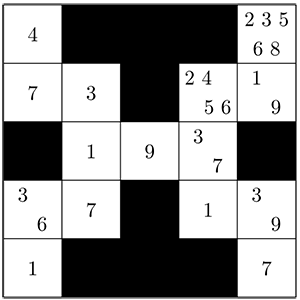I want to complete the cross figure shown here. I would like all eleven answers to be prime numbers and none to have a leading zero. Also I don’t want any digit to appear more than once in any row or column or on either of the two long diagonals.

Given the starting values shown, how many different ways could I complete the grid?
Reveal Solution
We use  for “1 down”, etc., and introduce notation as shown here:
for “1 down”, etc., and introduce notation as shown here:

Evidently and we rule out 5 of the possible six permutations as follows:
- If
or
or
then it quickly follows that
and
. This implies that
and this clashes with either
or
and these cases fail.
- If
then
and there is no way to choose
.
- If
then
and
which are numbers that neighbour
.
We are left with and the grid has been narrowed down to the summary on the right here:

To finish the job we look at cases according to . There are 4 possibilities:
- If
then every square is uniquely defined except
.
So there are two possible grids here. - If
then
and we can now consider two subcases according to
- If
then
and
. The grid is unique in this case.
- If
then
and
. Four different grids here.
- If
- If
then the grid is unique except
.
- If
then the grid is uniquely defined except for
.
There are eleven ways to complete the grid.



